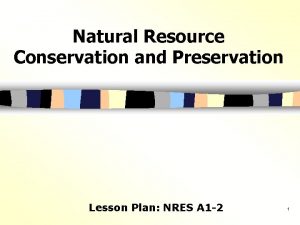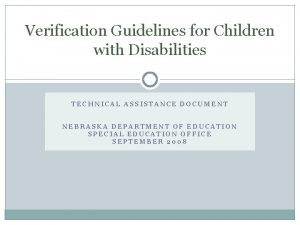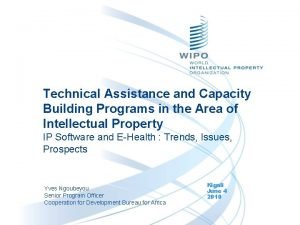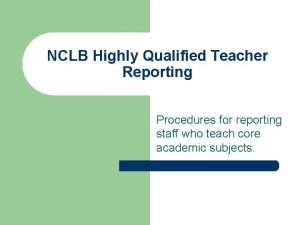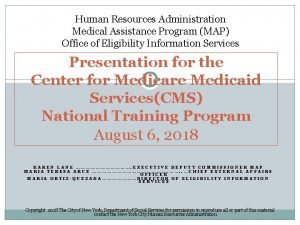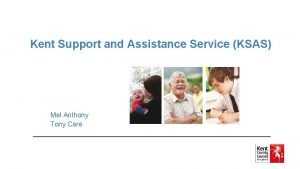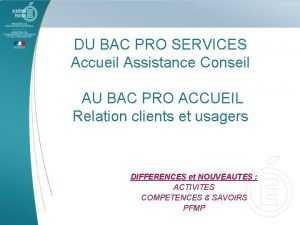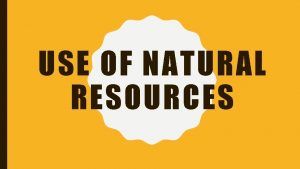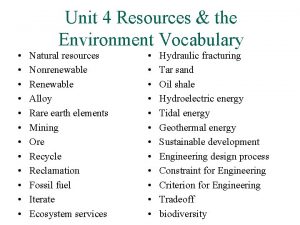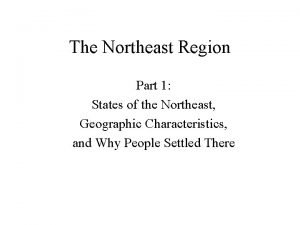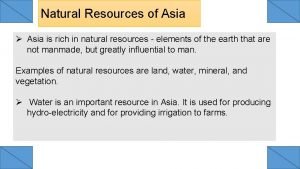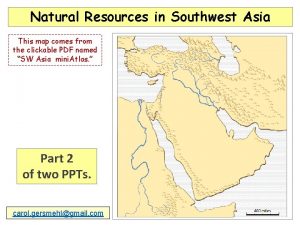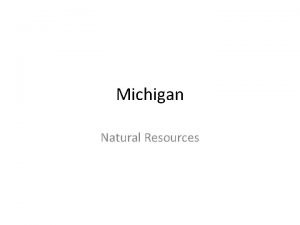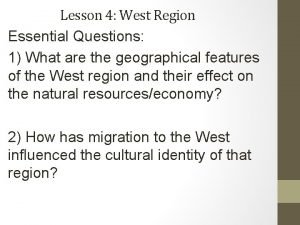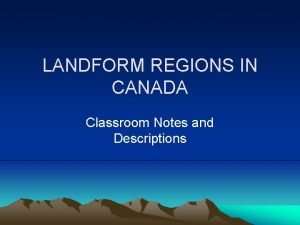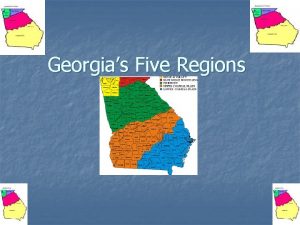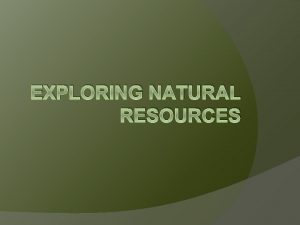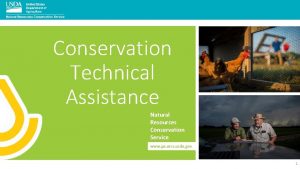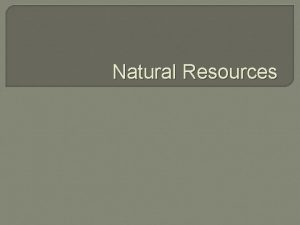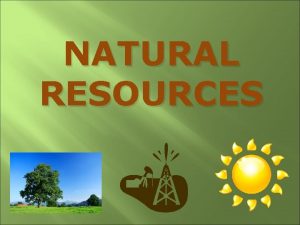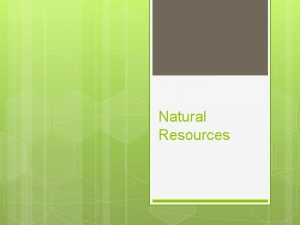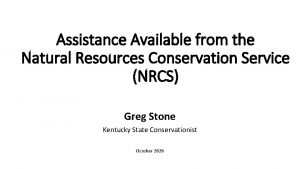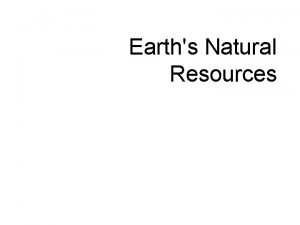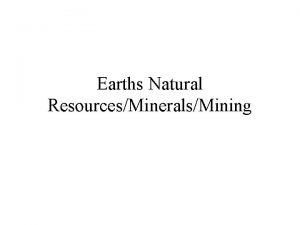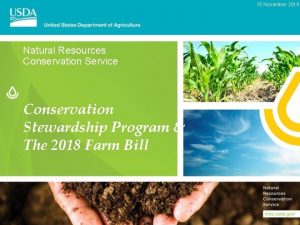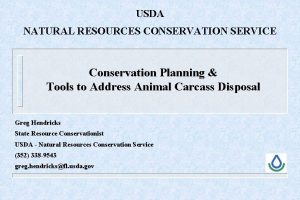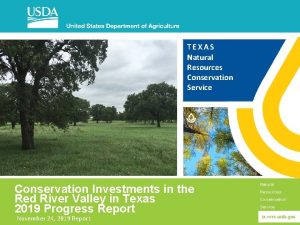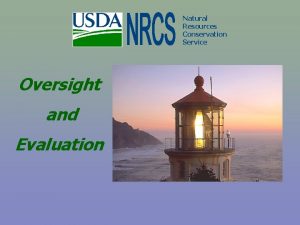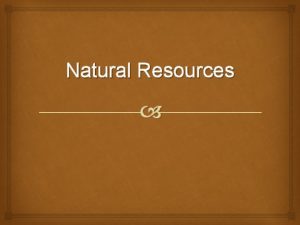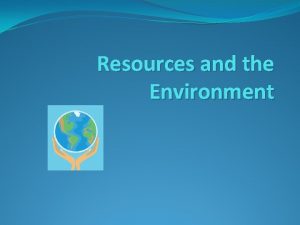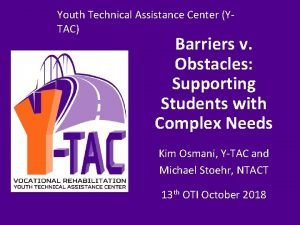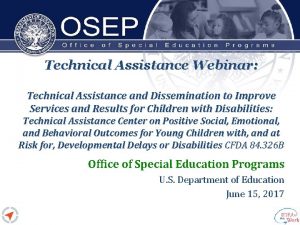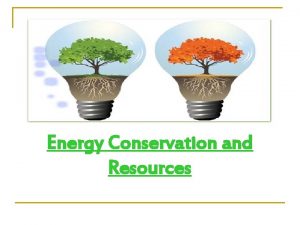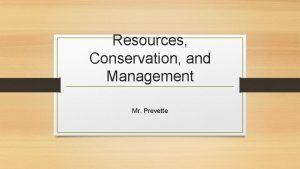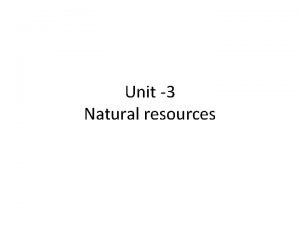Conservation Technical Assistance Natural Resources Conservation Service www






























- Slides: 30

Conservation Technical Assistance Natural Resources Conservation Service www. pa. nrcs. usda. gov 1

Communicating the Values of Conservation Technical Assistance This presentation will define: • Program Purpose, State of the Land, and Conservation Values • Customers • Authorizing Legislation, Regulations, and Agency Policies • Use of CTA at the Field Level • CTA and the Role of Partnerships • Use of CTA Above the Field Level January 2020 2

Purpose • Provide technical assistance to private landowners and other land managers • Provide technical assistance through a national network of locally respected, technically skilled, professional conservationists • Deliver technical assistance through conservation values that form the foundation of our agency • Produce environmental outcomes January 2020 3

America’s Private Lands: Conserve, Maintain, and Improve • 70 percent of the land (1. 4 billion acres) in the lower 48 States is owned by private landowners • 88 percent of all surface water falls on private land before reaching lakes, streams, and groundwater aquifers • The conservation health and productivity of private lands depends on the millions of individual decisions landowners make everyday January 2020 4

NRCS Conservation Values 1. Our conservation assistance is used VOLUNTARILY by our customers. 2. Science is the foundation for voluntary conservation on private lands. 3. Our conservation assistance is site-specific. 4. Natural resource concerns cannot be treated in isolation. We must use a systems approach. 5. Coordinated action should be encouraged on a watershed or landscape scale. 6. Local leadership and partnerships are critical to success. Dr. Hugh H. Bennett First Chief of SCS January 2020 5

Our Customers: A Broad Array Individuals Government Businesses • Farmers • Tribes, Nation-to- Nation • Ranchers • County and other local government units • Forest Landowners • State government (highway, health, recreation, water resources, and regional planning) • Professional consultants who provide engineering, planning, environmental assessment, tax assessment, and natural resource management services Private Nongovernmental Organizations • Citizen groups • Youth groups • Conservation groups • Federal departments and agencies such as Defense, Housing and Urban Development, Transportation, Heath and Human Services and Interior • Farm and ranch groups January 2020 6

NRCS Conservation Technical Assistance Through the Decades Soil erosion, sedimentation, and impacts on flooding Land & Water Conservation Fund Act (1965) 1930 s – 1950 s Soil Conservation and Domestic Allotment Act (1935) Partnerships and leveraging, innovation, landscape scale, streamlining, and results Connecting benefits of conservation practices and systems with natural resource improvement Soil & Water Resources Conservation Act (1977) 1960 s – 1970 s Soil Information Assistance for Community Planning & Resource Development Act (1966) Fertilizers/pesticide s and impacts on natural resources Land Conservation & Land Utilization Act of (1981) 1980 s – 1996 Farm Security & Rural Investment Act (2002) 1997 – 2008 2009 - Present Federal Agriculture Improvement & Reform Act (1996) Farm Bill conservation programs and funding growth Renewed funding for P. L. 566 January 2020 7 7

CTA Funding • Congress has changed the no-year designation for CTA Program funds to a two-year appropriation. • CTA funds are available for obligation for up to two fiscal years. January 2020 8

CTA Final Rule The CTA Program Rule, 7 CFR Part 610, provides the purpose and scope of the technical assistance furnished through the program. This rule provides that the CTA Program is the base technical assistance program for natural resource conservation for the NRCS is assigned responsibility by the Secretary of Agriculture for the technical phases of planning and applying conservation practices on the land through decisionmakers. January 2020 9

National Policies Governing Conservation Technical Assistance (Title 400, General Manual (GM), Part 400): decisionmaking relating to NRCS programs and related responsibilities and activities (190 -GM, Part 410). Public participation activities are to be consistent with the requirements of applicable Federal statutes, including the National Environmental Policy Act (NEPA) policy and regulations, Endangered Species Act (ESA) regulations, National Historic Preservation Act (NHPA) regulations and policy (36 CFR Part 800 and 420 -GM, Part 401), Indian Trust Responsibilities (410 -GM, Part 405), and Civil Rights requirements, as well as any applicable local or State statutes. Title 210, National Engineering Manual, P Part 501, Subpart A; Title 190, National Environmental Compliance Handbook, Part 610; Title 190, National Cultural Resources Procedures Handbook, Part 601. TSP citation for conservation application. 190 -GM, Part 405 Comprehensive Nutrient Management Planning (CNMP): CNMP development Title 440, Conservation Programs Manual (CPM), Part 525, (Title 450, General Manual (GM), Part 403) January 2020 10

What Products does CTA Deliver? The majority of funds for the CTA Program are used for staff costs (salary, benefits, etc. ) and other essential infrastructure support activities. These include products and services at the field, regional and State level — • Site-specific conservation planning and technical consultation • Areawide conservation planning and technical consultation • Technical assistant to help customers implement conservation practices and systems • Natural Resource Inventory (NRI) and Assessment • Development, evaluation, and distribution of conservation technologies and technical information. • Financial support for training, travel, and other activities associated with operating a nationwide field delivery system. January 2020 11

CTA is the Foundation • Provides a substantive level of technical expertise, background, and support for Federal, Tribal, State, and local conservation programs as well as other NRCS programs. • Enables other NRCS programs by facilitating Easements EWP CSP RCPP AMA EQIP Local cost-share programs FSA Farm Loans conservation planning, interagency coordination, technical consultations, and collaboration with decisionmakers that results in implementing Conservation Technical Assistance A Broad Foundation with Broad Congressional Authorities conservation practices and conservation systems. January 2020 12

CTA Program Objectives i. iii. iv. v. vi. viii. Provide conservation technical assistance to individuals or groups of decisionmakers, communities, conservation districts, units of State and local government, Tribes, and others to voluntarily conserve, maintain, and improve natural resources. Collect, analyze, interpret, display, and disseminate information about the status, condition, and trend of soil, water, and related natural resources so that people can make informed decisions for natural resource use and management. Provide soils and other natural resource information and interpretation to individuals or groups of decisionmakers, communities, States, and others to aid sound decision-making in the wise use and management of soil resources. Provide community, watershed, and areawide technical assistance in collaboration with units of government to develop and implement resource management plans that conserve, maintain, and improve natural resources. Provide conservation technical assistance to decisionmakers to assist them to comply with Federal, State, Tribal, and local environmental regulations and related requirements and to prepare them to become eligible to participate in other Federal, State, and local conservation programs. Develop, adapt, and transfer effective science-based technologies and tools for assessment, management, and conservation of natural resources. Provide conservation technical assistance to agricultural producers to comply with the highly erodible land (HEL) and wetland (Swampbuster) conservation compliance provisions of the Food Security Act of 1985, as amended. Assess the effects of conservation practices and systems on the condition of natural resources. January 2020 13

Technical Foundation for Our Programs and Services The strength of NRCS programs is only as good as its foundation, as provided by CTA which ensures we have: • A highly trained, technically skilled staff able to develop solutions customized for our customers • Site-specific conservation plans that are science-based • Science-based and time-proven conservation practice standards Science-based guides and technical information by which to plan and implement conservation practices Sound resource inventories Extensive implementation of technical training An avenue for innovation • • January 2020 14

CTA: Creating a Highly Skilled Workforce Employees are trained to plan and apply conservation practices and systems based on a site-specific basis. To do this, the workforce consists of many technical disciplines including the following: Agronomy Cultural Resources Forestry Range Conservation Anthropology Ecology Geology Sociology Archaeology Economics History Soil Conservation Biology Engineering Hydrology Soil Science January 2020 15

Delivering CTA at the Field Level • Combines art and science; a proven process, supported by experienced technical specialists • • Supports a planning process that is program neutral Provides the decision-maker a science-based product that recognizes that natural resource concerns cannot be treated in isolation – soil, water, air, plants, animals, and humans are all part of an integrated ecosystem with interdependencies Includes components that conservation planners factor in: • ◦ Farmer’s/Rancher’s objectives ◦ On-site effects and off-site impacts ◦ Alternative solutions that are practical and fit the operation – not a prescription of Best Management Practices (BMPs) ◦ Economic considerations (costs/benefits) ◦ Adaptive management; a living document to adjust to changing conditions, technologies, and lessons learned January 2020 16

Delivering CTA at the Field Level: The Nine Steps of Conservation Planning January 2020 17

Delivering CTA at the Field Level: Conservation Implementation • Survey, design, and lay out conservation practices on sites identified by the decisionmaker. • Provide assistance for installing and implementing conservation practices. • Certify that practices installed are in accordance with NRCS standards. January 2020 18

CTA and Farm Bill Compliance: HEL/Swampbuster Conservation Compliance CTA Program funds are used to assist agricultural producers in complying with the HEL and Wetland Conservation (Swampbuster) conservation compliance provisions of the Food Security Act of 1985, as amended. The objectives of these conservation compliance provisions are to— i. iii. iv. Reduce soil loss due to wind and water erosion. Protect the Nation’s long-term capability to produce food and fiber. Reduce sedimentation and improve water quality. Assist in preserving the functions and values of the Nation’s wetlands. January 2020 19

Areawide Planning • NRCS provides community, watershed, and areawide conservation planning assistance to local, State, and Federal agencies and Tribal governments • NRCS also may provide resource information for community, watershed, and area-wide planning efforts by others, including nongovernment consultants • Plans are developed with a client for a watershed or other geographic area defined by the client and stakeholders • This broad-scale conservation plan addresses all resource problems identified and contains alternative solutions January 2020 20

Implementing Federal, State, and Local Laws At a minimum, NRCS employees must have enough knowledge of Federal, State, Tribal, and local laws and regulations to— National Environmental Policy Act (NEPA) Endangered Species Act (ESA) (1) Recognize that a contemplated facility or practice may be subject to such laws and regulations. (2) Provide the landowner or operator with the name and address of the agency or National Historic Preservation Act (NHPA) official from whom application forms and detailed information can be obtained. (3) Furnish technical assistance for planning or implementing conservation practices that may be subject to the requirements of Federal, State, Tribal, or local laws and regulations. Other Federal, State, and local environmental and cultural resource protection policies, regulations, and Executive orders January 2020 21

The Conservation Partnership CTA works through a voluntary conservation network that fosters partnership between NRCS, conservation districts, state conservation agencies, and millions of private landowners. The Conservation Partnership expands NRCS’s ability to put conservation on the ground. January 2020 22

CTA and Our Work with Partners • NRCS works with conservation districts by participating in a locally led conservation process to assist individuals and groups with assessing conservation needs, making decisions, and implementing solutions. • Nationally, NRCS maintains memorandums of understanding with individual conservation districts • Gathering input from a broad range of individuals, agencies, organizations, businesses, and Tribal governments is essential to locally led conservation. January 2020 23

Locally Led Conservation has been Around for a Long Time. . . • 1935 Soil Conservation Act o Arkansas was the first to pass the law “What SCS needed was a representative who could walk over a man’s (or woman’s) land with him (or her), lay out a conservation plan, and come back to help him (or her) install the more difficult practices and structures. ” (R. J. Morgan, 1966) January 2020 24

Formation of the Soil and Water Conservation Districts and NRCS—a local team working together • After the 1935 Act was implemented, some people began to examine the best approach to get farmers interested in soil conservation. The most prominent individual was then Assistant Secretary, Milburn Wilson conceived of the conservation district, a subdivision of the state that the local people would organize for the district and spread the word of soil conservation. • Henry Wallace and FDR endorsed this concept and transmitted the Standard State Soil Conservation Districts Law to governors of the states on February 27, 1937. ◦ Arkansas was the first to pass the law. ◦ Brown Creek Soil Conservation District in North Carolina was the first to sign an agreement with NRCS for technical assistance and equipment. January 2020 25

Delivering CTA Above the Field Level • Soil and Water Resources Conservation Act of 1977 • Field Office Technical Guide (FOTG) • National Planning Procedures Handbook • NRI and CEAP January 2020 26

Soil and Water Resources Conservation Act of 1977 (RCA) National Program for Soil and Water Conservation The statute and policy states NRCS will develop and periodically update a program for furthering the conservation and protection of natural resources and provide reports to Congress and the public containing information gathered during the appraisal and the development of the program. January 2020 27

Field Office Technical Guides (FOTGs) are the primary scientific references for NRCS conservation technical assistance delivery and are available for use by other agencies and individuals. They contain technical information regarding the conservation of soil, water, air, related plant, animal, and human resources. January 2020 28

National Planning Procedures Handbook The National Planning Procedures Handbook provides consistent national policy and guidance for effective conservation planning at both site-specific and areawide basis. Conservation planning following these proven procedures integrates sciencebased resource assessment and conservation practice standards that are maintained in Field Office Technical Guides. January 2020 29

Evaluating Outcomes: NRI and CEAP National Resources Inventory (NRI) • Collects, analyzes, interprets, displays, and disseminates information regarding the status, condition, and trend of soil, water, and related natural resources • A statistical survey of land use and natural resource conditions and trends on non-Federal Conservation Effects and Assessment Project (CEAP) • Assessments of environmental benefits and effects of conservation programs • On a regional or watershed basis • Studies the benefits of most conservation practices and resource management systems implemented through conservation programs lands January 2020 30
 Lesson plan on conservation of natural resources
Lesson plan on conservation of natural resources Nde rule 51 technical assistance document
Nde rule 51 technical assistance document Sample technical assistance given to teachers
Sample technical assistance given to teachers Sample technical assistance given to teachers
Sample technical assistance given to teachers Sample technical assistance plan for teachers
Sample technical assistance plan for teachers Fda technical assistance network
Fda technical assistance network Darb medicaid
Darb medicaid Ksas application form
Ksas application form Navigational assistance service
Navigational assistance service Bac pro services accueil assistance conseil
Bac pro services accueil assistance conseil Transformation processes
Transformation processes Example of fixed resources
Example of fixed resources Renewable resources vs nonrenewable resources
Renewable resources vs nonrenewable resources Australia major natural resources
Australia major natural resources Central australia natural resources
Central australia natural resources What are the 4 types of natural resources
What are the 4 types of natural resources Natural resources vocabulary
Natural resources vocabulary Natural resources northeast region
Natural resources northeast region What are russia natural resources
What are russia natural resources Is asia rich in natural resources
Is asia rich in natural resources Natural resources of southwest asia
Natural resources of southwest asia What is michigan's natural resources
What is michigan's natural resources What are the natural resources in mexico
What are the natural resources in mexico West region natural resources
West region natural resources What are the physical features of the hudson bay lowlands
What are the physical features of the hudson bay lowlands Australia natural resources
Australia natural resources The five regions of georgia
The five regions of georgia Types of natural resources
Types of natural resources Japan major natural resources
Japan major natural resources Japan natural resources
Japan natural resources Japan natural resources
Japan natural resources
